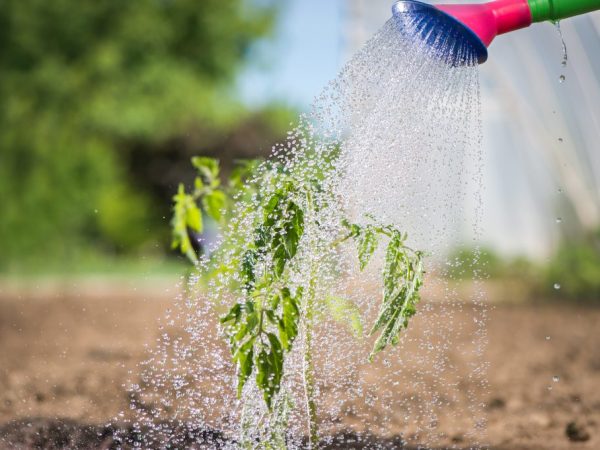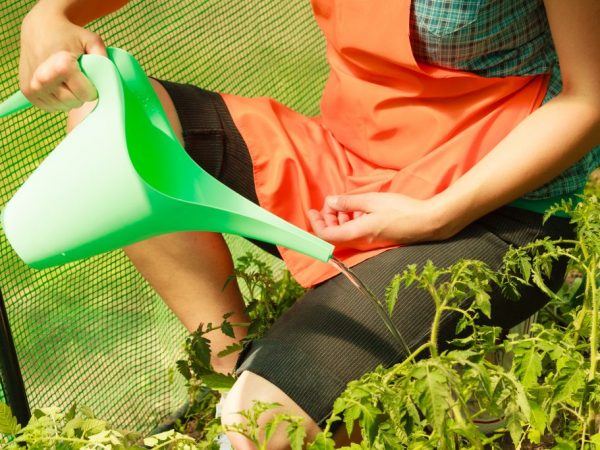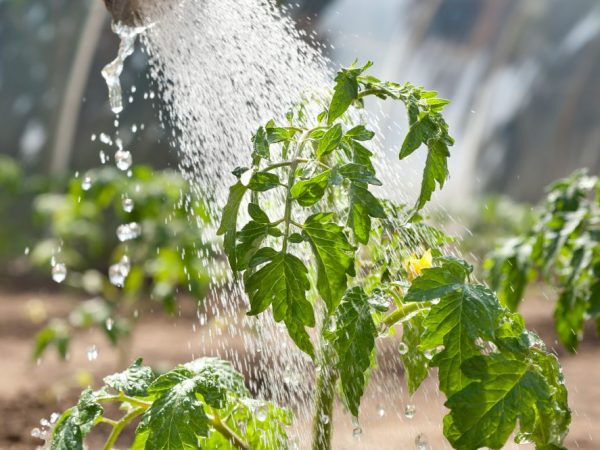How to properly water tomatoes in a greenhouse
Correct organization and implementation of agrotechnical measures when growing tomatoes in a greenhouse allows you to get a high-quality harvest. It is especially important to organize proper watering. Watering tomatoes in the greenhouse should be done with care. Due to the high humidity in the air, excess moisture can destroy the culture.

Rules for watering tomatoes in a greenhouse
Watering features
The tomato culture loves moisture, but does not tolerate overflow. Watering should be moderate and regular.
Depending on the climatic characteristics, gardeners moisten the soil at least 2 times a week. The frequency of watering tomatoes in the greenhouse is slightly different. The microclimate artificially created in the greenhouse has its own characteristics.
In summer, the air humidity in a polycarbonate greenhouse is in the range of 60-80%. Depending on the frequency of precipitation, and a sharp change in weather, this indicator can vary from 45% to 90%. And even regular airing will not completely correct this problem.
Pouring tomatoes can harm the seedlings. The root system begins to rot and the plant dies. By not filling them, the gardener runs the risk of getting a bad harvest. Moisture deficiency often causes the formation of small, tasteless fruits. Also, such conditions can cause overheating of plants and their subsequent death.
Watering rules
Water is the main food for tomatoes. The bushes at different stages of development contain from 60 to 80% moisture. In order for the seedlings to grow actively and move on to active fruiting, it is important to consider several rules for how to water tomatoes in a greenhouse:
- Tomatoes love dry air and moist soil. Therefore, a good solution for a polycarbonate greenhouse would be to mulch the soil with cut grass.
- Watering tomatoes in the greenhouse is carried out at the root of the plants. Water should not come into contact with tomato leaves. This can cause them to rot.
- It is best to water the seedlings in the morning. At this time, there is a minimal greenhouse effect. In addition, it is important that the plants do not fold or drop their leaves between treatments.
- The optimum water temperature is 23 ° C.
- Watering should be uniform. If this condition is not observed, the plants may overheat and die.
- During the fruiting period, the frequency of watering is reduced to a minimum. By the time of harvesting, experts advise him to stop moistening the soil.
Tatiana Orlova (Candidate of Agricultural Sciences):
Tomato is a crop that requires good water supply. The moisture content of the soil during the growing period should be on average in the range of 70-80% of the total field moisture capacity. On the other hand, tomato suffers greatly from high air humidity (optimal - 45-50%).
How much water should be applied, and how often should it be done? In polycarbonate greenhouses, it is recommended to water once a week. The optimal volume of liquid is 5 liters per plant.
Tatiana Orlova (Candidate of Agricultural Sciences):
All plants, including tomato, receive nutrition only in dissolved form. Lack of water during the growth of vegetative parts and ovaries leads to a condition called "dry hunger", i.e. macro- and microelements in the soil are contained in sufficient quantities, but due to the low moisture content of the soil, they are inaccessible to plants.
Watering methods
Watering tomatoes in a greenhouse can be carried out in different ways:
- manual (using a bucket, watering can, bucket or hose);
- drip (use of products for moistening the soil from plastic bottles);
- auto.
When choosing a method, it must be remembered that water should not get on the stem and leaves of the plant. Only the soil is moistened. Therefore, when using the manual method using a hose, it is forbidden to use the sprinkler heads.
Manual way

It is not recommended to get water on the leaves.
It is convenient to water the tomatoes in the greenhouse yourself if there is a barrel of water nearby. This is ideal for controlling the amount of water being poured under the bush.
It is better to water the tomatoes with a hose. The main thing is to monitor the volume of the liquid poured out and not to hit the plant leaves with a jet.
Drip method
The most effective way to moisturize the soil. The purchase and installation of special equipment for this requires physical and material costs. But there is also a budgetary way. Proper watering of tomatoes in a greenhouse can also be organized using a homemade drip installation. It is made from plastic bottles:
- It is necessary to prepare a bottle with a volume of 2 liters.
- With a knife or scissors, you should cut off the bottom of it.
- Holes are made in the lid (3-4 pcs.), With a diameter of 2-2.5 mm.
The resulting device must be inserted into the ground with the neck down.
Water is poured into the devices from bottles, which slowly moistens the soil, properly spreading to the root system of tomatoes. The only thing left for a person is to add water through an opening in the bottle accessible to him. You don't need to do this often. Due to the small holes in the lid, water consumption is minimal.
Automatic watering
Automated equipment is rarely used in the home growing of tomatoes. The most common types of soil moisture are:
- drip method;
- sprinkling;
- intrasoil method.
The most widespread are subsurface systems. With their application, soil moistening is carried out through a pipeline system hidden under the earth layer. Water enters the root system of plants through holes in the pipes. Such equipment has almost no drawbacks. The only disadvantage is the financial cost of purchasing an subsurface irrigation system.
Tatiana Orlova (Candidate of Agricultural Sciences):
The disadvantages of subsurface irrigation include, in addition to high costs, such a factor as the constant clogging of the holes in the perforated tubes with soil and roots (they have to be removed from the ground and cleaned from time to time).
Watering at different stages of growth
At different stages of growth, the plant needs a certain amount of liquid. Due to the fact that before the formation of ovaries, plants consume more than 80% of water, and during the fruiting period - 60-70%, the most important period for organizing such events is the first months of growing crops.
A period of active growth

Watering is important for tomatoes
It is important to properly water young tomatoes in the greenhouse during the period of active growth, because the plant at this time strongly draws moisture from the soil.
In young plants, the root system is not yet developed. They need to be watered once a week. The volume of liquid can vary from 1-3 liters per bush (depending on the age of the seedlings). During the period of active growth, the volume increases to 5 liters.
Flowering period
Special attention should be paid to soil moistening during flowering and ovary formation. During this time, tomatoes are most sensitive to moisture. Therefore, the ideal regimen for them will be 1 time per week, 10 liters. per sq.m.
You can reduce the number of procedures up to 3 times every 14 days.The volume of water does not change.
Fruit ripening period
When tomatoes turn red, they become less dependent on the amount of water they consume. In addition, excess liquid can damage the crop during the ripening period. Therefore, it is important to follow these rules:
- In mid-July, when the fruits ripen on the lower brushes, watering is reduced to 1 time in 10-12 days.
- At the end of July, they carry out punching (pinching of the main stem). This procedure allows you to stop the growth of plants and direct its forces to the ripening of existing fruits.
- At the beginning of July, the volume of the infused fluid is reduced. Experts recommend using no more than 8 liters of liquid per 1 sq. M. planted area.
During the period of full maturation, soil moisture must be stopped. Excessive moisture can lead to a loss of taste in tomatoes. Their aroma may also change. This time most often falls in mid-August.
Conclusion
It is possible to properly water tomatoes in greenhouses, taking into account the frequency of procedures, as well as controlling the amount of liquid poured under the bush. At each stage of plant development, there are agricultural standards.
Wanting to get a good harvest, the gardener must understand not only the methods of the event, but also in the process of performing the procedure itself. The fact is that it is often necessary to moisten only the soil. Water should not get on the leaves of the plant, as well as on its stem.


